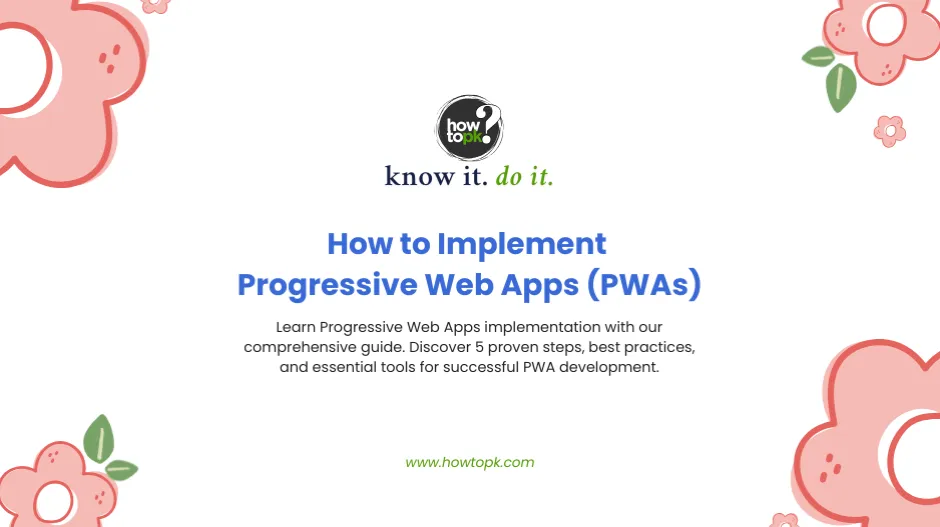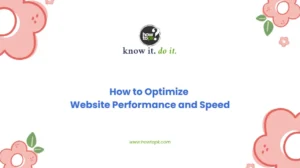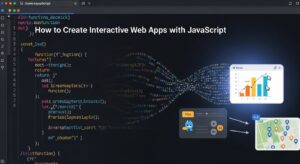Progressive Web Apps implementation has revolutionized how developers approach modern web development, combining the best of web and mobile applications. If you’re wondering how to transform your traditional website into a powerful, app-like experience, you’ve come to the right place.
What Are Progressive Web Apps and Why Should You Care?
Progressive Web Apps represent the future of web development, offering users native app-like experiences directly through web browsers. These applications work offline, send push notifications, and can be installed on users’ devices without requiring app store distribution.
The beauty of Progressive Web Apps implementation lies in their progressive enhancement philosophy. Your application works for every user, regardless of browser choice, while providing enhanced features for users with modern browsers.
Step 1: Establishing Your PWA Foundation
Before diving into Progressive Web Apps implementation, let’s establish what you need to get started.
Essential Prerequisites
Your journey begins with a solid understanding of modern web technologies. You’ll need familiarity with HTML5, CSS3, and JavaScript ES6+. Additionally, understanding of HTTPS protocols is crucial since PWAs require secure connections.
Setting Up Your Development Environment
Start by creating a basic web application structure. Your project should include:
- HTML files with semantic markup
- CSS for responsive design
- JavaScript for interactive functionality
- A local development server supporting HTTPS
Consider using tools like Create React App or Vue CLI which provide PWA templates out of the box.
Step 2: Creating Your Web App Manifest
The web app manifest serves as your PWA’s identity card. This JSON file tells browsers how your app should behave when installed on users’ devices.
Manifest File Structure
{
"name": "Your Progressive Web App",
"short_name": "YourPWA",
"description": "A powerful PWA implementation example",
"start_url": "/",
"display": "standalone",
"background_color": "#ffffff",
"theme_color": "#000000",
"icons": [
{
"src": "icon-192.png",
"sizes": "192x192",
"type": "image/png"
},
{
"src": "icon-512.png",
"sizes": "512x512",
"type": "image/png"
}
]
}
Key Manifest Properties
Understanding each property ensures successful Progressive Web Apps implementation:
- Display Modes: Choose between “standalone”, “fullscreen”, “minimal-ui”, or “browser” based on your app’s needs.
- Icons: Provide multiple icon sizes for different devices. Include at least 192×192 and 512×512 pixel versions.
- Start URL: Define where users land when launching your installed PWA.
Link your manifest in your HTML head section:
<link rel="manifest" href="/manifest.json">
Step 3: Implementing Service Workers for Offline Functionality
Service workers form the backbone of Progressive Web Apps implementation, enabling offline functionality and background synchronization.
Understanding Service Worker Lifecycle
Service workers operate independently of your main application thread, intercepting network requests and managing cache strategies. They follow a specific lifecycle: installation, activation, and message handling.
Basic Service Worker Setup
Create a sw.js file in your root directory:
const CACHE_NAME = 'pwa-cache-v1';
const urlsToCache = [
'/',
'/styles/main.css',
'/scripts/main.js',
'/images/logo.png'
];
self.addEventListener('install', event => {
event.waitUntil(
caches.open(CACHE_NAME)
.then(cache => cache.addAll(urlsToCache))
);
});
self.addEventListener('fetch', event => {
event.respondWith(
caches.match(event.request)
.then(response => {
return response || fetch(event.request);
})
);
});
Register your service worker in your main JavaScript file:
if ('serviceWorker' in navigator) {
navigator.serviceWorker.register('/sw.js')
.then(registration => console.log('SW registered'))
.catch(error => console.log('SW registration failed'));
}
Advanced Caching Strategies
Successful Progressive Web Apps implementation requires thoughtful caching strategies:
Strategy | Use Case | Implementation Complexity |
Cache First | Static assets, images | Low |
Network First | API calls, dynamic content | Medium |
Cache Only | Offline pages | Low |
Network Only | Analytics, logging | Low |
Stale While Revalidate | Frequently updated content | Medium |
Step 4: Ensuring Responsive Design and Performance
Progressive Web Apps implementation demands mobile-first thinking and optimized performance across all devices.
Responsive Design Principles
Your PWA must work seamlessly across screen sizes. Use flexible grid systems and responsive images. Consider using CSS frameworks like Bootstrap or Tailwind CSS for rapid development.
Implement viewport meta tags:
<meta name="viewport" content="width=device-width, initial-scale=1">
Performance Optimization Techniques
Focus on these critical performance metrics:
- First Contentful Paint (FCP): Optimize by minimizing render-blocking resources and using efficient loading strategies.
- Largest Contentful Paint (LCP): Ensure your largest content element loads quickly through image optimization and critical resource prioritization.
- Cumulative Layout Shift (CLS): Prevent layout shifts by specifying dimensions for images and dynamic content.
Use tools like Lighthouse to audit your Progressive Web Apps implementation and identify improvement opportunities.
Step 5: Testing and Deployment Strategies
Comprehensive testing ensures your Progressive Web Apps implementation works flawlessly across different environments and devices.
Local Testing Approaches
Start with Chrome DevTools’ Application tab to inspect your manifest, service workers, and storage. Test offline functionality by simulating network conditions.
Use the PWA testing checklist:
- Manifest validation
- Service worker registration
- Offline functionality
- Install prompts
- Performance benchmarks
Production Deployment Considerations
Deploy your PWA to HTTPS-enabled hosting. Popular options include Netlify, Vercel, or Firebase Hosting.
Configure proper HTTP headers for caching and security:
- Set appropriate cache headers for static assets
- Implement Content Security Policy (CSP)
- Enable HTTP/2 for improved performance
Cross-Browser Testing
While Progressive Web Apps implementation works best in modern browsers, ensure graceful degradation in older browsers. Test across:
- Chrome and Chromium-based browsers
- Firefox
- Safari (limited PWA support)
- Edge
Advanced PWA Features and Implementation
Push Notifications
Implement push notifications to re-engage users. This requires server-side setup and user permission handling:
navigator.serviceWorker.ready.then(registration => {
return registration.pushManager.subscribe({
userVisibleOnly: true,
applicationServerKey: urlBase64ToUint8Array(publicVapidKey)
});
});
Background Sync
Enable background synchronization for offline data submission using the Background Sync API:
self.addEventListener('sync', event => {
if (event.tag === 'background-sync') {
event.waitUntil(doBackgroundSync());
}
});
Common Implementation Challenges and Solutions
- Service Worker Update Strategies: Handle service worker updates gracefully by implementing update notifications and automatic activation strategies.
- Browser Compatibility Issues: Address compatibility concerns by implementing feature detection and providing fallbacks for unsupported browsers.
- Performance Optimization: Monitor and optimize your Progressive Web Apps implementation continuously using performance monitoring tools and user feedback.
Tools and Resources for PWA Development
Essential tools for successful Progressive Web Apps implementation include:
- PWA Builder for quick PWA setup
- Workbox for advanced service worker management
- Web App Manifest Generator for manifest creation
Measuring PWA Success
Track key metrics to evaluate your Progressive Web Apps implementation:
- Installation rates
- User engagement metrics
- Performance scores
- Offline usage statistics
Use analytics tools and performance monitoring to continuously improve your PWA experience.
Conclusion
Progressive Web Apps implementation represents a significant opportunity to enhance user experience while reducing development complexity. By following these five essential steps—establishing your foundation, creating your manifest, implementing service workers, ensuring responsive design, and thorough testing—you’ll create powerful web applications that compete with native mobile apps.
The future of web development lies in Progressive Web Apps. Start your implementation journey today and transform how users interact with your web applications. Remember, successful Progressive Web Apps implementation is an iterative process that improves with user feedback and technological advances.
Ready to begin your Progressive Web Apps implementation? Start with a simple manifest file and gradually add advanced features as you become more comfortable with PWA concepts. Your users will thank you for the improved experience, and you’ll appreciate the streamlined development process.











